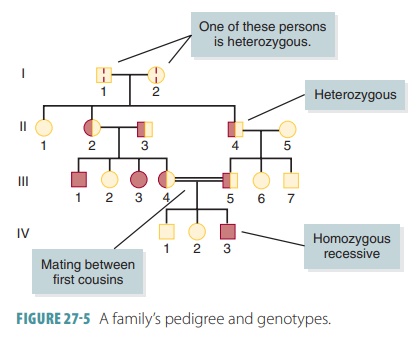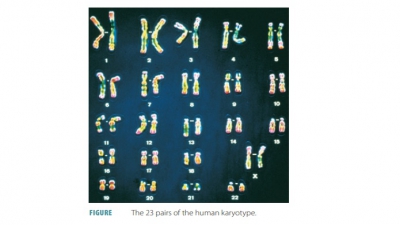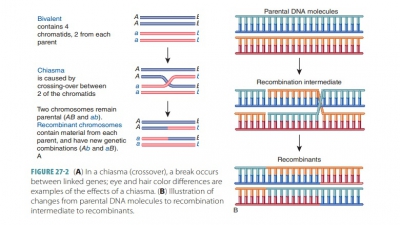Genetic Screening
| Home | | Anatomy and Physiology | | Anatomy and Physiology Health Education (APHE) |Chapter: Anatomy and Physiology for Health Professionals: Heredity
Today, genetic screening and counseling help parents to become more educated and to make choices about having children.
Genetic
Screening
Today, genetic screening and counseling help parents to
become more educated and to make choices about having children. Newly born
infants are reg-ularly screened for anatomical disorders such as congenital hip dysplasia and imperforate anus. Anatomical defects are usually
surgically corrected. Infants are also tested for metabolic diseases such as
PKU. This condition is managed by strict diets that exclude most foods
containing phenylalanine. Genetic screening alerts parents of needed
treat-ments in order to keep their children healthy. Adult children of parents
who have Huntington’s disease are also helped by genetic screening and
counsel-ing. Women who become pregnant at age 35 or later may seek genetic
screening for the possibility of their babies having trisomy 21, also known as
Down syndrome. This condition occurs more often in the babies of older mothers.
Genetic screening can occur before a baby is conceived by recognizing carriers
of genetic conditions or during fetal testing.
Carrier Recognition
Carriers of genetic conditions are identified in two basic
methods:
■■ Pedigree:
The tracing of a genetic trait through several
generations, which helps to predict future outcomes; phenotype information on
as many fam-ily members as possible is used; a pedigree is also called a
“family tree”; rules of dominant-recessive inheritance are applied to deduce
genotypes of par-ents and determine genotypes of others in the same generation
as the parents (FIGURE
27-5)
■■ Blood
tests: Used to screen for sickling genes in heterozygotes; blood
chemistry tests and DNA probes detect presence of other
unexpressed, recessive genes such as
carriers of Tay-Sachs dis-ease and cystic fibrosis.

Fetal Testing
When there is a known risk of a genetic disorder, fetal
testing is performed. The most common method is via amniocentesis. A wide bore needle is inserted
through the mother’s abdominal wall into the amni-otic sac. Approximately, 10
mL of fluid is withdrawn. This procedure is usually performed after the 14th
week of pregnancy, so that the fetus is not injured by removing the needed
amount of fluid. Ultrasound is used to visualize the fetal position as well as
the posi-tion of the amniotic sac. This procedure is extremely safe. The
amniotic fluid is checked for enzymes and other chemicals that are markers for
certain diseases. Most tests are performed on the sloughed-off fetal cells
found in the fluid. For over several weeks, the cells are cultured in
laboratory dishes, then examined for DNA markers of genetic disease. They are
karyo-typed to check for chromosomal abnormalities.
Another procedure called chorionic villus sampling (CVS) uses suctioning of parts
of the chori-onic villi from the placenta through a catheter inserted into the
cervix. One of the main advantages of having this test instead of amniocentesis
is that it can be done earlier in pregnancy. Ultrasound is used to guide this
insertion to a region where a piece of placental tissue may be removed. This
procedure can be performed as early as the eighth week of pregnancy, though the
10th week is recommended. Karyotyping can be performed almost immediately. The
rapidly dividing chorionic cells can, therefore, be assessed at a much earlier
time than is possible with amniocentesis. With CVS, there is an increased risk
of defects of the fingers and toes of the fetus. Along with amniocentesis, CVS
is regularly ordered for pregnant women over 35 due to the higher risk of Down
syndrome. Both procedures are also per-formed on younger mothers when the
likelihood of a severe fetal disorder is higher than the probability of any
harm caused by the procedures.
Both amniocentesis and CVS will become obso-lete because of
advances in the sequencing of DNA. Today, maternal blood samples can be
obtained easily, to examine free-floating maternal DNA as well as the DNA of
the fetus that is released from the placenta. Maternal blood samples are tested
for Down syn-drome and other fetal chromosomal abnormalities. Similar blood
testing can give information about the fetal genome, identifying mutations that
may make it more likelihood for certain diseases to develop.
Human Gene Therapy
Human gene therapy is helping to treat or cure vari-ous
disorders, especially those caused by a single gene or protein that is
defective. It is possible to insert a virus that contains a functional gene
into defective cells. Another method is to inject DNA that has been “corrected”
into a patient’s cells. These therapies have shown varying results in treating
muscular dystrophy and cystic fibrosis. Genetic engineering is still very
expensive, however, and there are opposing opinions about its ethics,
infringement on religious beliefs, and how it can or should be used.
1. What common disorders are routinely checked for by using
genetic screening?
2. Describe a “pedigree.”
3. Contrast how amniocentesis and CVS are performed.


